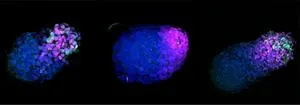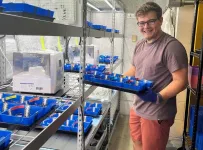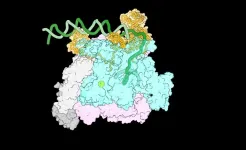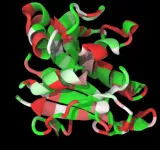(Press-News.org) Stem cell-based embryo models (SCBEMs) are three-dimensional biological structures that mimic aspects of early human embryo development. They can be created in the lab from stem cells, and can provide new insights into critical stages of early human development that are normally inaccessible to researchers.
Embryo model work is expected to lead to new interventions for a range of conditions, including revolutionising treatments for recurrent miscarriage, understanding developmental disorders and improving the success rate of IVF.
Although embryo models are not the same as human embryos, they mimic aspects of early human development - and this has raised ethical concerns.
The previous lack of a regulatory framework for the use of SCBEMs in research has left scientists and research organisations uncertain about the acceptable boundaries of their work, both legally and ethically, and unsupported in their decision-making. Signing up to the SCBEM Code of Practice will remove these obstacles.
The guidelines, released today, provide the first code of practice for the use of stem cell-based embryo models in the UK.
“The new Code of Practice provides processes for decision-making in research using stem cell-based embryo models so that scientists can proceed confidently, while maintaining public trust in this vital area of research,” said Kathy Niakan, Chair of Cambridge Reproduction and Professor of Reproductive Physiology at the University of Cambridge, and member of the SCBEM Code of Practice Working Group.
“We are confident that the Code will enable the UK to continue to lead the world in research into early human development, while ensuring that this research is ethically robust,” said Professor Roger Sturmey, Professor of Reproductive Medicine at Hull York Medical School and Chair of the SCBEM Code of Practice Working Group.
Key points of the Code
The new SCBEM Code of Practice sets out standards to make sure that research using SCBEMs is rigorous, upholds ethical principles and maximises the potential benefits. Key to this will be a dedicated Oversight Committee that will review each proposed research project.
The Code recognises that there must be a limit to how long embryo models can be grown in the lab. However, many different types of embryo model are being developed, representing distinct developmental stages and developing at different rates, making it impossible to impose a single fixed limit. Instead, researchers are asked to provide clear justification of the length of their experiments on a case-by-case basis.
The Code prohibits any human SCBEM from being transferred into the womb of a human or animal, or being allowed to develop into a viable organism in the lab.
“Embryo models have huge potential and we want to realise this, while also limiting the risks. The new Code of Practice will allow stem cell-based embryo models to be grown in the lab long enough to gain meaningful biological understanding, but the Code asks researchers to fully justify what they’re doing in scientific and ethical terms,” said Niakan.
How are embryo models useful to research?
Research using embryo models can improve knowledge of human development, including early pregnancy loss and pregnancy disorders, congenital defects and the precursor events that affect adult human health and disease.
The models could also be used for some investigations that are not permitted using human embryos. For example, there are currently significant limitations to clinical trials and the use of many medicines during pregnancy. Models of early development could be helpful to improve options for drug treatments during pregnancy in the future.
Stem cell-based embryo models open new research avenues that can complement, but not replace, the limited studies possible with actual human embryos. The SCBEM Code of Practice states that neither of these areas of research can or should replace the other for the foreseeable future.
How was the Code produced?
The SCBEM Code of Practice Working Group was made up of researchers and practitioners at institutions across the UK, including experts in science, law, ethics and regulation. In drawing up the Code, the team consulted widely with researchers, practitioners, and major funders and regulators of embryo model research, both within the UK and internationally.
The SCBEM Code of Practice Working Group included researchers and practitioners from the Babraham Institute, Biolawgy, Brighton and Sussex Medical School, the Centre of Medical Law and Ethics at King's College London, the Francis Crick Institute, Hull York Medical School, the Medical Research Council, Newcastle University, University College London, the University of Cambridge, the University of Edinburgh, the University of Exeter and the University of Manchester.
The work was also informed by a public dialogue, held earlier this year, to explore public attitudes towards research involving embryo models.
“Throughout the process of developing the Code of Practice, we’ve been keen to engage with as wide a range of stakeholders as possible, including researchers, experts in law and bioethics, regulators and funders,” said Christina Rozeik, Programme Manager of Cambridge Reproduction and member of the SCBEM Code of Practice Project Team.
She added: “A public dialogue enabled us to include public voices during the development of the Code, taking account of their hopes, concerns and sensitivities around research involving stem cell-based embryo models. Participants were excited by the potential of embryo model research, but also strongly supportive of oversight.”
“Research involving stem cell-based embryo models has enormous potential to improve human knowledge and health, but clearer governance is needed to help researchers work responsibly and maintain public trust. Our Code of Practice addresses this need. It takes into account an extensive range of expert and lay perspectives we’ve gathered over the past year,” said Sandy Starr, Deputy Director of the Progress Educational Trust (PET) and member of the SCBEM Code of Practice Project Team.
How will the Code be enforced?
The Code is not legislative, but the team proposes that it should be adopted by UK researchers, funders, research organisations, professional societies and publishers.
Widespread use is expected to set a new precedent for reporting research utilising stem cell-based embryo models and deter the funding and publication of research that fails to meet the standards set out in the Code. As a result, adherence to the Code will become an essential part of credible science, providing increased transparency and accountability for embryo model research.
Given the rapid pace of research using embryo models, the Code will be reviewed regularly.
“Research using stem cell-based embryo models is very new, and our understanding of the science is rapidly evolving. We’ve taken the opportunity to respond to the current situation, and we’ll continue to update the Code of Practice as the science continues to develop,” said Niakan.
“Establishing this guidance takes stem cell-based embryo models out of the grey zone and onto more stable footing so we can fully explore their usefulness, while providing the essential reassurance that this research is being conducted carefully and with appropriate scrutiny,” said Dr Peter Rugg-Gunn, Group Leader and Head of Public Engagement at the Babraham Institute, and member of the SCBEM Code of Practice Working Group.
Creation of the SCBEM Code of Practice (fully titled: Code of Practice for the Generation and Use of Human Stem Cell-Based Embryo Models) was led by Cambridge Reproduction - an interdisciplinary research centre at the University of Cambridge - in partnership with the Progress Educational Trust (PET) - a charity that improves choices for people affected by infertility and genetic conditions.
END
Pioneering Code of Practice released for use of stem cell-based embryo models in research
2024-07-04
ELSE PRESS RELEASES FROM THIS DATE:
First study to measure toxic metals in tampons shows arsenic and lead, among other contaminants
2024-07-04
Tampons from several brands that potentially millions of people use each month can contain toxic metals like lead, arsenic, and cadmium, a new study led by a UC Berkeley researcher has found.
Tampons are of particular concern as a potential source of exposure to chemicals, including metals, because the skin of the vagina has a higher potential for chemical absorption than skin elsewhere on the body. In addition, the products are used by a large percentage of the population on a monthly basis—50-80% of those who menstruate use tampons—for several hours at a time.
“Despite this large potential for public health concern, very little research ...
Rice researchers uncover key mechanisms in chromosome structure development
2024-07-03
Researchers at Rice University are making strides in understanding how chromosome structures change throughout the cell’s life cycle. Their study on motorized processes that actively influence the organization of chromosomes was published in the Proceedings of the National Academy of Science.
“This research provides a deeper understanding of how motorized processes shape chromosome structures and influence cellular functions,” said Peter Wolynes, study co-author and the D.R. Bullard-Welch Foundation Professor of Science. ...
Rice research aims to reprogram the genetic code
2024-07-03
Rice University chemist Han Xiao has been awarded nearly $2 million from the National Institutes of Health Maximizing Investigators’ Research Award (MIRA) program for established investigators.
All organisms with few exceptions use 20 standard amino acids to build proteins. Xiao’s research aims to reprogram the genetic code to precisely manipulate biological systems by using noncanonical amino acids (ncAAs) with diverse properties to help build proteins. Researchers generally use ncAAs to investigate the structure and dynamics of proteins, but Xiao wants to take that a step further.
“This innovative approach could revolutionize how ...
Home test reveals the risk of heart attack in five minutes
2024-07-03
Swedish researchers have created a questionnaire test for home use that quickly identifies high risk of heart attack. A study shows that it has the same level of accuracy as blood tests and blood pressure measurements.
The study, published in Journal of the American Heart Association, uses data from the SCAPIS population study, which is based at the University of Gothenburg, with the Swedish Heart Lung Foundation as its main sponsor.
The study was led by Göran Bergström, Professor of Clinical Physiology at Sahlgrenska Academy at the University of Gothenburg, senior ...
New tuberculosis vaccine results presented at FAPESP Week China
2024-07-03
Researchers from the Butantan Institute and collaborators are developing a more potent version of the BCG vaccine that protects against tuberculosis. While the conventional immunizer reduced infection by 90% in experiments with mice, the so-called recombinant BCG increased the protection rate to 99%. In addition, the new formulation protected the animals for a significantly longer period of time.
“BCG is the first vaccine we receive at birth, and it’s indeed effective in protecting children. But immunity against the disease tends to wane in adulthood, and as bacteria are becoming resistant to antibiotics, no ...
Wastewater is a viable medium for growing lettuce in hydroponic systems, study shows
2024-07-03
URBANA, Ill. – Urban agriculture has the potential to improve food security through local, efficient, and sustainable food production. Examples of urban food systems include hydroponics, where plants grow in a nutrient solution without soil, and aquaponics, which combines hydroponics with raising fish in tanks.
A new study from the University of Illinois Urbana-Champaign examines the use of aquaponics wastewater as a growth medium for lettuce in a hydroponic system. This practice can potentially ...
Researchers capture never-before-seen view of gene transcription
2024-07-03
Every living cell transcribes DNA into RNA. This process begins when an enzyme called RNA polymerase (RNAP) clamps onto DNA. Within a few hundred milliseconds, the DNA double helix unwinds to form a node known as the transcription bubble, so that one exposed DNA strand can be copied into a complementary RNA strand.
How RNAP accomplishes this feat is largely unknown. A snapshot of RNAP in the act of opening that bubble would provide a wealth of information, but the process happens too quickly for current technology to easily capture visualizations ...
Do genes-in-pieces code for proteins that fold in pieces?
2024-07-03
A new study led by Rice University’s Peter Wolynes offers new insights into the evolution of foldable proteins. The research was published in the Proceedings of the National Academy of Sciences.
Researchers at Rice and the University of Buenos Aires used energy landscape theory to distinguish between foldable and nonfoldable parts of protein sequences. Their study illuminates the ongoing debate about whether the pieces of DNA that code for only part of a protein during their origins can fold on their own.
The researchers focused on the extensive relationship between exons in protein structures and the evolution of protein foldability. They highlighted ...
Can inflammation in early adulthood affect memory, thinking in middle age?
2024-07-03
MINNEAPOLIS – Having higher levels of inflammation in your 20s and 30s may be linked to having memory and thinking problems at middle age, according to a study published in the July 3, 2024, online issue of Neurology®, the medical journal of the American Academy of Neurology. The study looked at levels of C-reactive protein (CRP) in the blood. CRP is produced by the liver and increases when there is inflammation in the body. The study does not prove that having higher levels of this protein causes dementia. It only shows an association.
There are two kinds of inflammation. Acute inflammation happens when the body’s immune response jumps into action to fight off infection or ...
Poor health, stress in 20s takes toll in 40s with lower cognition
2024-07-03
Higher inflammation in young adulthood linked to lower performance in skills testing in midlife.
Young adults who have higher levels of inflammation, which is associated with obesity, physical inactivity, chronic illness, stress and smoking, may experience reduced cognitive function in midlife, a new study out of UC San Francisco has found.
Researchers previously linked higher inflammation in older adults to dementia, but this is one of the first studies to connect inflammation in early adulthood with lower cognitive abilities in midlife.
“We know from long-term studies that brain changes leading to Alzheimer’s ...








